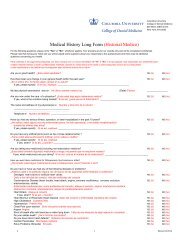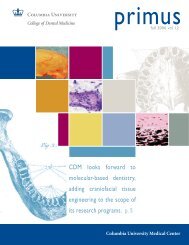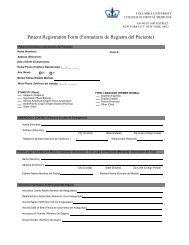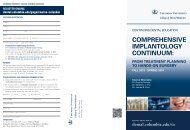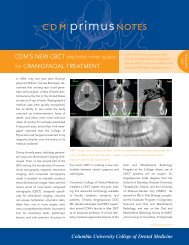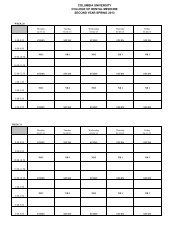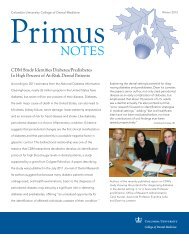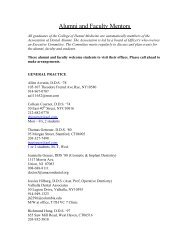Jarvie Journal - College of Dental Medicine - Columbia University
Jarvie Journal - College of Dental Medicine - Columbia University
Jarvie Journal - College of Dental Medicine - Columbia University
You also want an ePaper? Increase the reach of your titles
YUMPU automatically turns print PDFs into web optimized ePapers that Google loves.
Volume 56, Spring 2013<br />
Shear Bond Strengths <strong>of</strong> Pressed and Layered Fluorapatite Glass Ceramic and<br />
CAD/CAM Milled Lithium Disilicate Veneering Ceramic to Zirconia Cores<br />
Junhyung Park 1 , Thomas Hill 2 , Anthony Randi 1*<br />
1 Postgraduate Prosthodontics, <strong>College</strong> <strong>of</strong> <strong>Dental</strong> <strong>Medicine</strong>, <strong>Columbia</strong> <strong>University</strong>, NY, NY; 2 Ivoclar Vivadent,<br />
Amherst, NY; *Faculty Mentor<br />
Introduction: All ceramic restorations are gaining market share due to their favorable<br />
properties over metal ceramic restorations. Advantages <strong>of</strong> all ceramic restorations are their<br />
excellent biocompatibility and esthetic properties such as high translucency and absence <strong>of</strong> a<br />
metal margin. Zirconia and lithium disilicate restorations clinical acceptance has increased due<br />
to their high strength and improved clinical success which is comparable to metal ceramic<br />
restorations. However, one <strong>of</strong> the most common complications for Zirconia restorations is<br />
fracture <strong>of</strong> the veneering porcelain. Fractures <strong>of</strong> porcelain can either be cohesive within the<br />
veneering porcelain or adhesive between the veneering porcelain and core material. Ceramic<br />
pressing techniques have been developed as an alternative to layering ceramic on metal and<br />
zirconium cores. Varying methods for veneering restorations can result in different ceramic<br />
strength.<br />
Objective: The purpose <strong>of</strong> this study is to compare the shear bond strength <strong>of</strong> zirconia with<br />
CAD/CAM milled lithium disilicate veneering ceramic using a sintering technique to zirconia<br />
pressed with fluorapatite glass ceramic using press-on technique and conventional fluorapatite<br />
glass ceramic layering technique.<br />
Materials and Methods: 60 zirconia plates were divided into three groups, 1) conventional<br />
layered, 2) pressed and 3) CAD-on. The veneering porcelain or lithium disilicate was fired<br />
according to manufacturer’s recommendation. 20 samples <strong>of</strong> POM (pressed on metal) using<br />
base metal was used as a control group. Samples were placed into a mounting jig and shear<br />
bond strength was evaluated using a Universal Instron machine.<br />
Results: The mean shear strength was 28.9MPa-POM group, 19.1MPa- layered group,<br />
20.1MPa - pressed group, and 60.5MPa- CAD-on group. The CAD-on group showed<br />
statistically significant difference among other groups (P



